Construction Management: Second Storey Building Analysis Report
VerifiedAdded on 2023/06/10
|11
|2677
|84
Report
AI Summary
This construction management report analyzes a project involving adding a second storey to an existing single-storey brick veneer house. The report addresses the structural engineer's required analyses, highlighting potential structural challenges such as ensuring compatibility between the existing and proposed storeys, material selection, and the foundation's capacity. It explains various loads and forces, including dead, live, snow, and wind loads, and describes the load paths from the roof to the foundation. The report further explores considerations for a new double-storey home, including building permit requirements, necessary drawings, the National Construction Code's influence on design and construction, and light and ventilation regulations. The report also outlines the construction process, detailing the main trades involved and construction methods, and discusses components, subsystems, and systems that will make up the proposed building, along with technical drawings of truss systems. Finally, the report provides advice on window selection, comparing aluminum and timber-framed options, considering factors such as cost, maintenance, and environmental impact. The report references multiple sources to support the analysis.

Construction Management 1
Construction Management
Name
Course
Professor
University
City/state
Date
Construction Management
Name
Course
Professor
University
City/state
Date
Paraphrase This Document
Need a fresh take? Get an instant paraphrase of this document with our AI Paraphraser
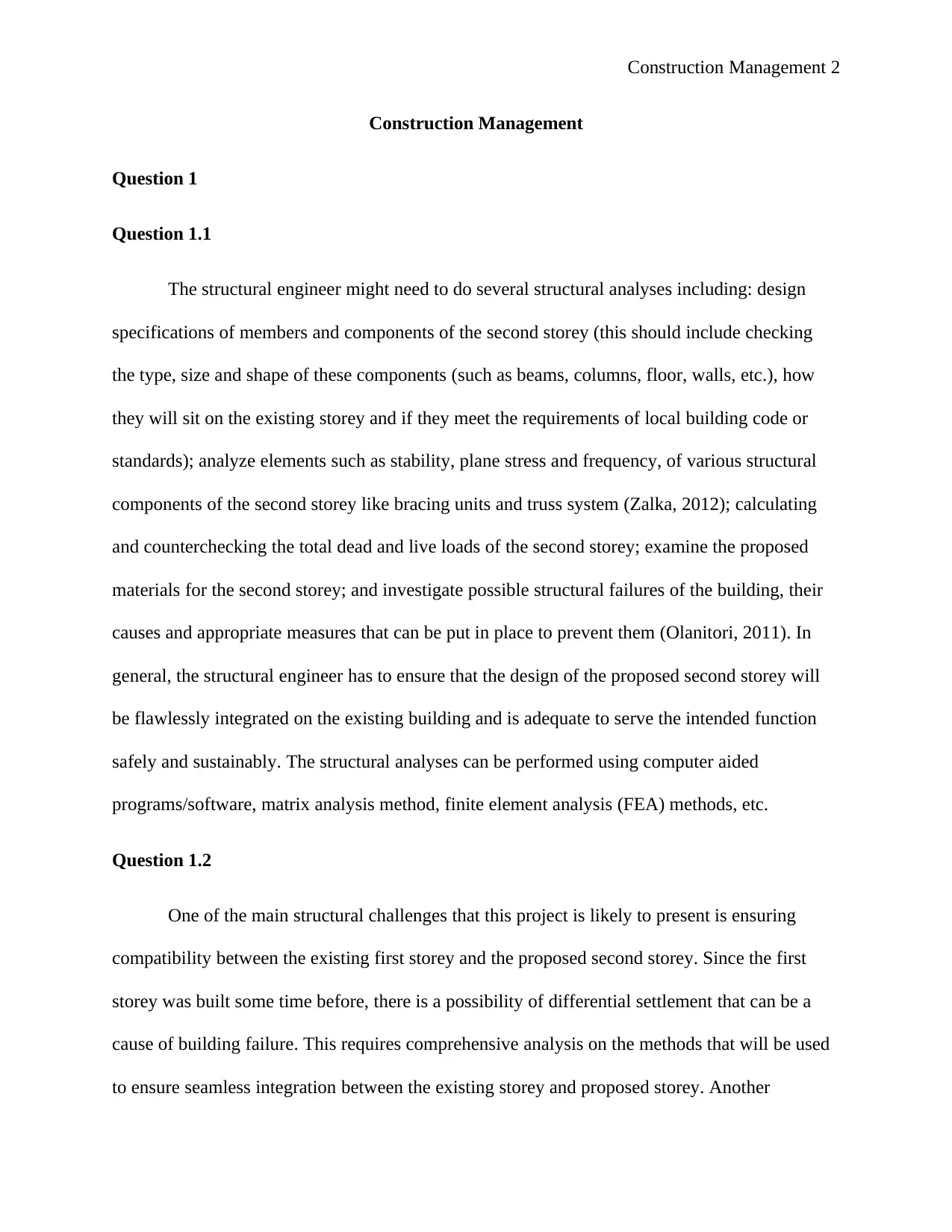
Construction Management 2
Construction Management
Question 1
Question 1.1
The structural engineer might need to do several structural analyses including: design
specifications of members and components of the second storey (this should include checking
the type, size and shape of these components (such as beams, columns, floor, walls, etc.), how
they will sit on the existing storey and if they meet the requirements of local building code or
standards); analyze elements such as stability, plane stress and frequency, of various structural
components of the second storey like bracing units and truss system (Zalka, 2012); calculating
and counterchecking the total dead and live loads of the second storey; examine the proposed
materials for the second storey; and investigate possible structural failures of the building, their
causes and appropriate measures that can be put in place to prevent them (Olanitori, 2011). In
general, the structural engineer has to ensure that the design of the proposed second storey will
be flawlessly integrated on the existing building and is adequate to serve the intended function
safely and sustainably. The structural analyses can be performed using computer aided
programs/software, matrix analysis method, finite element analysis (FEA) methods, etc.
Question 1.2
One of the main structural challenges that this project is likely to present is ensuring
compatibility between the existing first storey and the proposed second storey. Since the first
storey was built some time before, there is a possibility of differential settlement that can be a
cause of building failure. This requires comprehensive analysis on the methods that will be used
to ensure seamless integration between the existing storey and proposed storey. Another
Construction Management
Question 1
Question 1.1
The structural engineer might need to do several structural analyses including: design
specifications of members and components of the second storey (this should include checking
the type, size and shape of these components (such as beams, columns, floor, walls, etc.), how
they will sit on the existing storey and if they meet the requirements of local building code or
standards); analyze elements such as stability, plane stress and frequency, of various structural
components of the second storey like bracing units and truss system (Zalka, 2012); calculating
and counterchecking the total dead and live loads of the second storey; examine the proposed
materials for the second storey; and investigate possible structural failures of the building, their
causes and appropriate measures that can be put in place to prevent them (Olanitori, 2011). In
general, the structural engineer has to ensure that the design of the proposed second storey will
be flawlessly integrated on the existing building and is adequate to serve the intended function
safely and sustainably. The structural analyses can be performed using computer aided
programs/software, matrix analysis method, finite element analysis (FEA) methods, etc.
Question 1.2
One of the main structural challenges that this project is likely to present is ensuring
compatibility between the existing first storey and the proposed second storey. Since the first
storey was built some time before, there is a possibility of differential settlement that can be a
cause of building failure. This requires comprehensive analysis on the methods that will be used
to ensure seamless integration between the existing storey and proposed storey. Another

Construction Management 3
structural challenge is the type of materials used (Malo, et al., 2016). The structural engineer has
to strike a balance between the functionality, durability, cost and sustainability of the materials
used to build the second storey. The capability of the foundation of the building to support the
additional load of the second storey is another key structural challenge (Gong, et al., 2017).
Another structural challenge in this project is ensuring that design details of the second storey,
such as beams, columns, walls, etc. are of similar size to those of the existing first storey. Last
but not least is the construction method to be used – it should not affect the structural soundness
or functionality of the existing building.
Question 1.3
Some of the different loads/forces relevant to the proposed building and others in general
include both dead and live loads such as dead loads, live/imposed loads, snow loads, wind loads,
hydrostatic pressure, seismic/earthquake loads, thermal loads, special loads, erection loads,
fatigue, impact, fluid and soil pressure, elastic axial shortening, foundation movement, settlement
loads, stress concentration, dynamic loads, flood load, earth load, rain load, etc. (Munach, 2018);
(The Constructor, 2017). The loads can act in a vertical direction, horizontal direction or
longitudinal direction (at an inclined angle). The loads can also be categorized as line loads,
concentrated loads and surface/distributed loads.
Question 1.4
The typical load paths of buildings are from top downwards, although there are
alternative load paths (Luu, 2015). This means that the loads will be transferred from the roof to
the foundation through multiple integrated members of the building. These components have to
be connected properly for continuous and seamless transfer of the loads from top to bottom. In
structural challenge is the type of materials used (Malo, et al., 2016). The structural engineer has
to strike a balance between the functionality, durability, cost and sustainability of the materials
used to build the second storey. The capability of the foundation of the building to support the
additional load of the second storey is another key structural challenge (Gong, et al., 2017).
Another structural challenge in this project is ensuring that design details of the second storey,
such as beams, columns, walls, etc. are of similar size to those of the existing first storey. Last
but not least is the construction method to be used – it should not affect the structural soundness
or functionality of the existing building.
Question 1.3
Some of the different loads/forces relevant to the proposed building and others in general
include both dead and live loads such as dead loads, live/imposed loads, snow loads, wind loads,
hydrostatic pressure, seismic/earthquake loads, thermal loads, special loads, erection loads,
fatigue, impact, fluid and soil pressure, elastic axial shortening, foundation movement, settlement
loads, stress concentration, dynamic loads, flood load, earth load, rain load, etc. (Munach, 2018);
(The Constructor, 2017). The loads can act in a vertical direction, horizontal direction or
longitudinal direction (at an inclined angle). The loads can also be categorized as line loads,
concentrated loads and surface/distributed loads.
Question 1.4
The typical load paths of buildings are from top downwards, although there are
alternative load paths (Luu, 2015). This means that the loads will be transferred from the roof to
the foundation through multiple integrated members of the building. These components have to
be connected properly for continuous and seamless transfer of the loads from top to bottom. In
⊘ This is a preview!⊘
Do you want full access?
Subscribe today to unlock all pages.

Trusted by 1+ million students worldwide

Construction Management 4
this case, the loads will be transferred from the roof to the second storey beams then to the
columns and walls. From columns and walls on the second storey, the loads will be transferred to
the second storey floor slab then to the beams. From the beams, the loads will be transferred to
the first storey columns and walls then to the first storey floor slab. The loads will then be
transferred to the beams, then to the columns and walls on the ground floor then to the
foundation. From the foundation, the loads will be transferred to the ground. The horizontal and
vertical load paths are as shown in Figure 1 and 2 below.
Figure 1: Horizontal load paths (Drexel University Academic Building, (n.d.))
Figure 2: Vertical load paths (Drexel University Academic Building, (n.d.))
this case, the loads will be transferred from the roof to the second storey beams then to the
columns and walls. From columns and walls on the second storey, the loads will be transferred to
the second storey floor slab then to the beams. From the beams, the loads will be transferred to
the first storey columns and walls then to the first storey floor slab. The loads will then be
transferred to the beams, then to the columns and walls on the ground floor then to the
foundation. From the foundation, the loads will be transferred to the ground. The horizontal and
vertical load paths are as shown in Figure 1 and 2 below.
Figure 1: Horizontal load paths (Drexel University Academic Building, (n.d.))
Figure 2: Vertical load paths (Drexel University Academic Building, (n.d.))
Paraphrase This Document
Need a fresh take? Get an instant paraphrase of this document with our AI Paraphraser

Construction Management 5
Question 2
Question 2.1
First, the client should be aware of the type of houses or house designs (in terms of size,
height, orientation, use, etc.) that are allowed to be constructed in the General Residential Zone
(GRZ). Second, the process of applying for a building permit, including the requirements (such
as documents, charges, etc.). Third, any heritage structures, trees or plants on or near the site that
requires to be protected. Fourth, any requirements on energy and water efficiency of the building
throughout its lifecycle. Fifth, requirements on bushfire risk reduction. Last but not least is any
other requirements that are related to construction of buildings in the area, such as minimum
percentage of lot size that should be set aside as garden area, waste reduction and management,
health and safety, height of fences, allowable size of the extension, etc. (State Government of
Victoria, 2018).
Question 2.2
The various types of drawings required for issuance of a building permit include the following:
Survey drawings – they should provide information about the exact location of the
building, showing the boundaries of the site.
Site plan – it should provide information about the entire context of the building i.e. the
exact location of the building, nearby structures and means of accessing the site.
Floor plan – they should provide information about the layout of different rooms in the
building.
Elevations – they should provide information about how the building looks from different
sides (north, south, west and east views).
Question 2
Question 2.1
First, the client should be aware of the type of houses or house designs (in terms of size,
height, orientation, use, etc.) that are allowed to be constructed in the General Residential Zone
(GRZ). Second, the process of applying for a building permit, including the requirements (such
as documents, charges, etc.). Third, any heritage structures, trees or plants on or near the site that
requires to be protected. Fourth, any requirements on energy and water efficiency of the building
throughout its lifecycle. Fifth, requirements on bushfire risk reduction. Last but not least is any
other requirements that are related to construction of buildings in the area, such as minimum
percentage of lot size that should be set aside as garden area, waste reduction and management,
health and safety, height of fences, allowable size of the extension, etc. (State Government of
Victoria, 2018).
Question 2.2
The various types of drawings required for issuance of a building permit include the following:
Survey drawings – they should provide information about the exact location of the
building, showing the boundaries of the site.
Site plan – it should provide information about the entire context of the building i.e. the
exact location of the building, nearby structures and means of accessing the site.
Floor plan – they should provide information about the layout of different rooms in the
building.
Elevations – they should provide information about how the building looks from different
sides (north, south, west and east views).
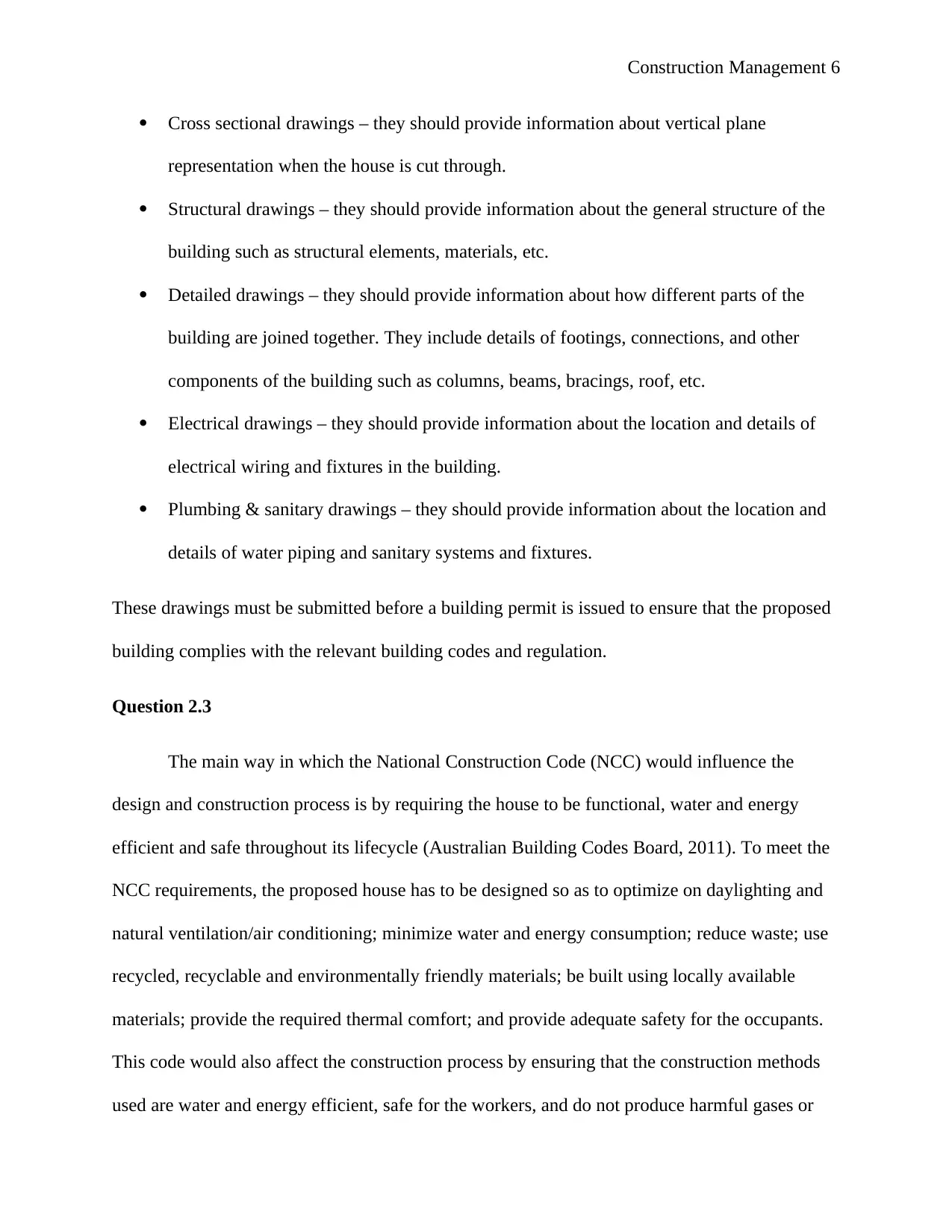
Construction Management 6
Cross sectional drawings – they should provide information about vertical plane
representation when the house is cut through.
Structural drawings – they should provide information about the general structure of the
building such as structural elements, materials, etc.
Detailed drawings – they should provide information about how different parts of the
building are joined together. They include details of footings, connections, and other
components of the building such as columns, beams, bracings, roof, etc.
Electrical drawings – they should provide information about the location and details of
electrical wiring and fixtures in the building.
Plumbing & sanitary drawings – they should provide information about the location and
details of water piping and sanitary systems and fixtures.
These drawings must be submitted before a building permit is issued to ensure that the proposed
building complies with the relevant building codes and regulation.
Question 2.3
The main way in which the National Construction Code (NCC) would influence the
design and construction process is by requiring the house to be functional, water and energy
efficient and safe throughout its lifecycle (Australian Building Codes Board, 2011). To meet the
NCC requirements, the proposed house has to be designed so as to optimize on daylighting and
natural ventilation/air conditioning; minimize water and energy consumption; reduce waste; use
recycled, recyclable and environmentally friendly materials; be built using locally available
materials; provide the required thermal comfort; and provide adequate safety for the occupants.
This code would also affect the construction process by ensuring that the construction methods
used are water and energy efficient, safe for the workers, and do not produce harmful gases or
Cross sectional drawings – they should provide information about vertical plane
representation when the house is cut through.
Structural drawings – they should provide information about the general structure of the
building such as structural elements, materials, etc.
Detailed drawings – they should provide information about how different parts of the
building are joined together. They include details of footings, connections, and other
components of the building such as columns, beams, bracings, roof, etc.
Electrical drawings – they should provide information about the location and details of
electrical wiring and fixtures in the building.
Plumbing & sanitary drawings – they should provide information about the location and
details of water piping and sanitary systems and fixtures.
These drawings must be submitted before a building permit is issued to ensure that the proposed
building complies with the relevant building codes and regulation.
Question 2.3
The main way in which the National Construction Code (NCC) would influence the
design and construction process is by requiring the house to be functional, water and energy
efficient and safe throughout its lifecycle (Australian Building Codes Board, 2011). To meet the
NCC requirements, the proposed house has to be designed so as to optimize on daylighting and
natural ventilation/air conditioning; minimize water and energy consumption; reduce waste; use
recycled, recyclable and environmentally friendly materials; be built using locally available
materials; provide the required thermal comfort; and provide adequate safety for the occupants.
This code would also affect the construction process by ensuring that the construction methods
used are water and energy efficient, safe for the workers, and do not produce harmful gases or
⊘ This is a preview!⊘
Do you want full access?
Subscribe today to unlock all pages.

Trusted by 1+ million students worldwide
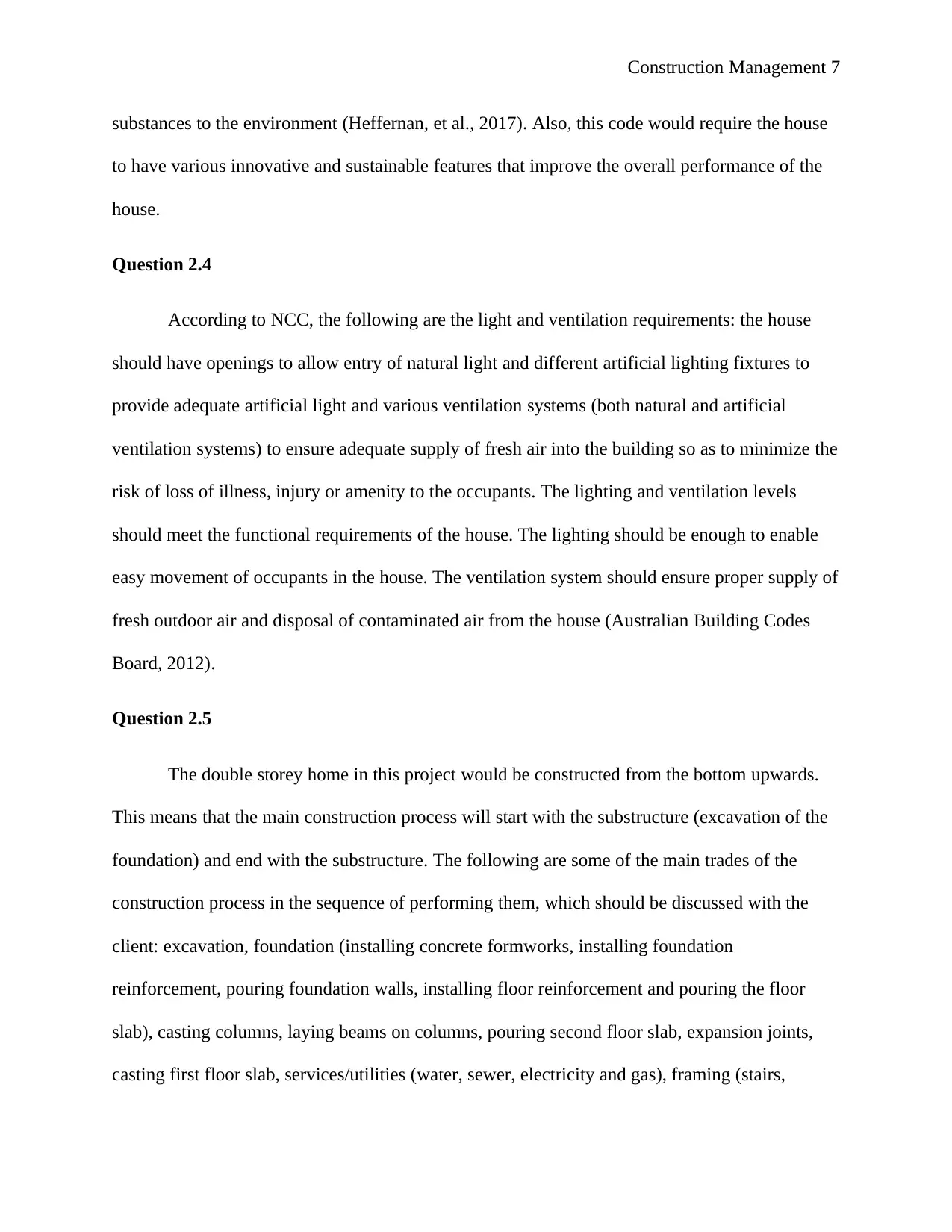
Construction Management 7
substances to the environment (Heffernan, et al., 2017). Also, this code would require the house
to have various innovative and sustainable features that improve the overall performance of the
house.
Question 2.4
According to NCC, the following are the light and ventilation requirements: the house
should have openings to allow entry of natural light and different artificial lighting fixtures to
provide adequate artificial light and various ventilation systems (both natural and artificial
ventilation systems) to ensure adequate supply of fresh air into the building so as to minimize the
risk of loss of illness, injury or amenity to the occupants. The lighting and ventilation levels
should meet the functional requirements of the house. The lighting should be enough to enable
easy movement of occupants in the house. The ventilation system should ensure proper supply of
fresh outdoor air and disposal of contaminated air from the house (Australian Building Codes
Board, 2012).
Question 2.5
The double storey home in this project would be constructed from the bottom upwards.
This means that the main construction process will start with the substructure (excavation of the
foundation) and end with the substructure. The following are some of the main trades of the
construction process in the sequence of performing them, which should be discussed with the
client: excavation, foundation (installing concrete formworks, installing foundation
reinforcement, pouring foundation walls, installing floor reinforcement and pouring the floor
slab), casting columns, laying beams on columns, pouring second floor slab, expansion joints,
casting first floor slab, services/utilities (water, sewer, electricity and gas), framing (stairs,
substances to the environment (Heffernan, et al., 2017). Also, this code would require the house
to have various innovative and sustainable features that improve the overall performance of the
house.
Question 2.4
According to NCC, the following are the light and ventilation requirements: the house
should have openings to allow entry of natural light and different artificial lighting fixtures to
provide adequate artificial light and various ventilation systems (both natural and artificial
ventilation systems) to ensure adequate supply of fresh air into the building so as to minimize the
risk of loss of illness, injury or amenity to the occupants. The lighting and ventilation levels
should meet the functional requirements of the house. The lighting should be enough to enable
easy movement of occupants in the house. The ventilation system should ensure proper supply of
fresh outdoor air and disposal of contaminated air from the house (Australian Building Codes
Board, 2012).
Question 2.5
The double storey home in this project would be constructed from the bottom upwards.
This means that the main construction process will start with the substructure (excavation of the
foundation) and end with the substructure. The following are some of the main trades of the
construction process in the sequence of performing them, which should be discussed with the
client: excavation, foundation (installing concrete formworks, installing foundation
reinforcement, pouring foundation walls, installing floor reinforcement and pouring the floor
slab), casting columns, laying beams on columns, pouring second floor slab, expansion joints,
casting first floor slab, services/utilities (water, sewer, electricity and gas), framing (stairs,
Paraphrase This Document
Need a fresh take? Get an instant paraphrase of this document with our AI Paraphraser
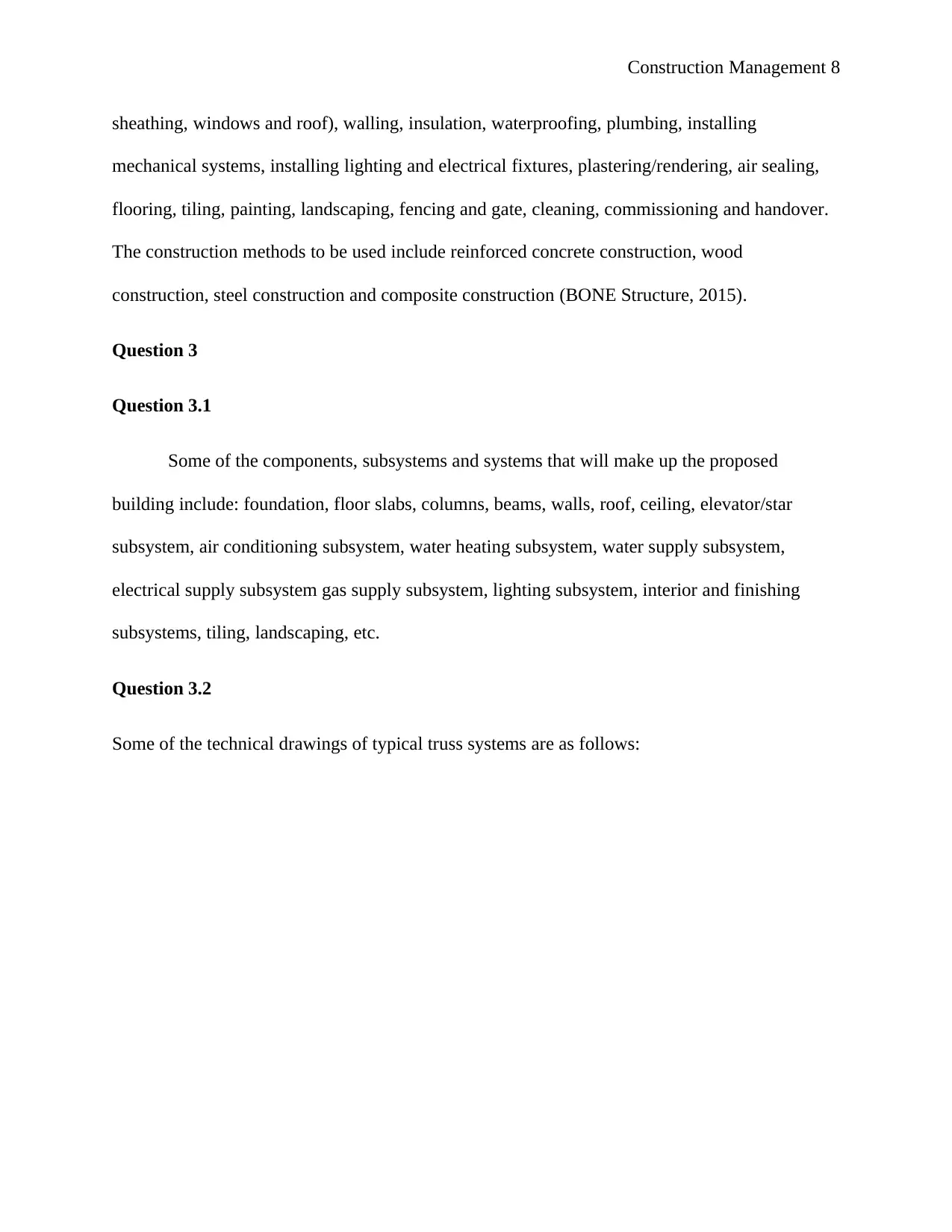
Construction Management 8
sheathing, windows and roof), walling, insulation, waterproofing, plumbing, installing
mechanical systems, installing lighting and electrical fixtures, plastering/rendering, air sealing,
flooring, tiling, painting, landscaping, fencing and gate, cleaning, commissioning and handover.
The construction methods to be used include reinforced concrete construction, wood
construction, steel construction and composite construction (BONE Structure, 2015).
Question 3
Question 3.1
Some of the components, subsystems and systems that will make up the proposed
building include: foundation, floor slabs, columns, beams, walls, roof, ceiling, elevator/star
subsystem, air conditioning subsystem, water heating subsystem, water supply subsystem,
electrical supply subsystem gas supply subsystem, lighting subsystem, interior and finishing
subsystems, tiling, landscaping, etc.
Question 3.2
Some of the technical drawings of typical truss systems are as follows:
sheathing, windows and roof), walling, insulation, waterproofing, plumbing, installing
mechanical systems, installing lighting and electrical fixtures, plastering/rendering, air sealing,
flooring, tiling, painting, landscaping, fencing and gate, cleaning, commissioning and handover.
The construction methods to be used include reinforced concrete construction, wood
construction, steel construction and composite construction (BONE Structure, 2015).
Question 3
Question 3.1
Some of the components, subsystems and systems that will make up the proposed
building include: foundation, floor slabs, columns, beams, walls, roof, ceiling, elevator/star
subsystem, air conditioning subsystem, water heating subsystem, water supply subsystem,
electrical supply subsystem gas supply subsystem, lighting subsystem, interior and finishing
subsystems, tiling, landscaping, etc.
Question 3.2
Some of the technical drawings of typical truss systems are as follows:
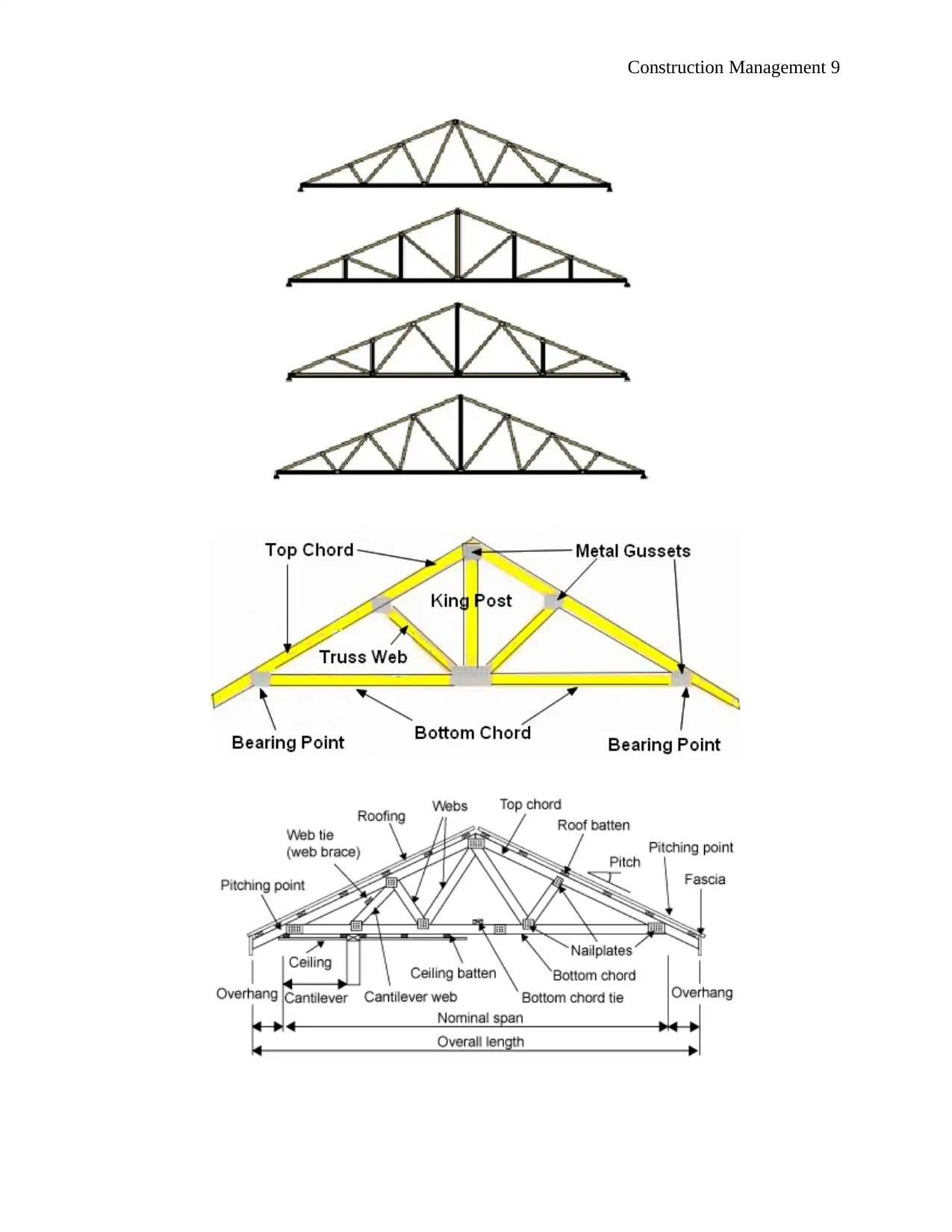
Construction Management 9
⊘ This is a preview!⊘
Do you want full access?
Subscribe today to unlock all pages.

Trusted by 1+ million students worldwide

Construction Management 10
The main components of the truss system are: top chord, bottom chord, king post, webs, web tie,
gussets, fascia, roof batten and roofing material/sheet/cover.
Question 3.3
I would advise the owner to keep using aluminium framed windows. The main
advantages of aluminium framed windows include: high strength, lower cost, minimal
maintenance, lightweight, ease of installation, and available in different shapes and sizes. Since
timber framed windows have higher maintenance needs, using them will cost the owner more
money considering that the house is a double storey building. The main disadvantages of
aluminium framed windows are poor insulator and high likelihood of condensation. On the other
hand, advantages of timber framed windows are environmentally friendly, natural insulator thus
reducing energy costs, available in different styles, and natural beauty. Some of the
disadvantages of timber framed windows include: heavier than aluminium framed windows,
highly priced, high maintenance needs, etc. (Mackenzie, 2017). Aluminium framed windows are
also 100 recyclable and can withstand extreme weather (Architecture & Design, 2008).
However, the owner has to ensure that the aluminium framed windows are coated and painted
properly so as to make them more resistant to external environmental conditions.
There are several factors that must be considered when choosing between aluminium
framed windows or timber framed systems. Some of these include: local building codes and
regulations, availability, their performance (in terms of insulation and heat absorption/transfer,
strength, weight, ease of installation, maintenance requirements, footprint, cost, weather
tightness, durability, energy efficiency, environmental impacts, etc.
The main components of the truss system are: top chord, bottom chord, king post, webs, web tie,
gussets, fascia, roof batten and roofing material/sheet/cover.
Question 3.3
I would advise the owner to keep using aluminium framed windows. The main
advantages of aluminium framed windows include: high strength, lower cost, minimal
maintenance, lightweight, ease of installation, and available in different shapes and sizes. Since
timber framed windows have higher maintenance needs, using them will cost the owner more
money considering that the house is a double storey building. The main disadvantages of
aluminium framed windows are poor insulator and high likelihood of condensation. On the other
hand, advantages of timber framed windows are environmentally friendly, natural insulator thus
reducing energy costs, available in different styles, and natural beauty. Some of the
disadvantages of timber framed windows include: heavier than aluminium framed windows,
highly priced, high maintenance needs, etc. (Mackenzie, 2017). Aluminium framed windows are
also 100 recyclable and can withstand extreme weather (Architecture & Design, 2008).
However, the owner has to ensure that the aluminium framed windows are coated and painted
properly so as to make them more resistant to external environmental conditions.
There are several factors that must be considered when choosing between aluminium
framed windows or timber framed systems. Some of these include: local building codes and
regulations, availability, their performance (in terms of insulation and heat absorption/transfer,
strength, weight, ease of installation, maintenance requirements, footprint, cost, weather
tightness, durability, energy efficiency, environmental impacts, etc.
Paraphrase This Document
Need a fresh take? Get an instant paraphrase of this document with our AI Paraphraser

Construction Management 11
References
Architecture & Design, 2008. Timber versus Aluminium. [Online]
Available at: https://www.architectureanddesign.com.au/news/industry-news/timber-versus-aluminium
[Accessed 8 June 2018].
Australian Building Codes Board, 2011. National Construction Code, Victoria: Australian Government.
Australian Building Codes Board, 2012. National Contruction Code Series 2012 Guide To Volume One,
Canberra: Australian Building Codes Board.
BONE Structure, 2015. Construction Methods: What Are Your Options?. [Online]
Available at: https://bonestructure.ca/en/articles/construction-methods-what-are-your-options/
[Accessed 8 June 2018].
Drexel University Academic Building, (n.d.). Load Paths. [Online]
Available at: https://sites.google.com/site/duacademicbuilding/structural-system/load-paths
[Accessed 7 June 2018].
Gong, J., Cui, W. & Yuan, Y., 2017. Monolithic Pouring of the Foundation Slab of the 632 m High‐
Shanghai Tower. Structural Concrete, 18(3), pp. 381-396.
Heffernan, E., Beazley, S., McCarthy, T. & Sohel, M., 2017. Energy Efficiency Within Mid-Rise Residential
Buildings: A Critical Review of Regulations in Australia. Energy Procedia, Volume 121, pp. 292-299.
Luu, N., 2015. Analytical Simplify Model of the Key Elements in the Alternative Load Path Within the
Frame in Accidental Situation, Ostrava: Technical University of Ostrava - VSB- TUO.
Mackenzie, T., 2017. Aluminium or Wooden Windows - Which is Best for Me?. [Online]
Available at: https://builderscrack.co.nz/blog/2017/05/18/aluminium-or-wooden-windows/
[Accessed 8 June 2018].
Malo, K., Abrahamsen, R. & Bjertnaes, M., 2016. Some Structural Design Issues of the 14-Storey Timber
Framed Building "Treet" in Norway. European Journal of Wood and Wood Products, 74(3), pp. 407-424.
Munach, R., 2018. How It Works: Building Loads. [Online]
Available at: https://www.finehomebuilding.com/2010/05/20/how-it-works-building-loads
[Accessed 7 June 2018].
Olanitori, L., 2011. Causes of Structural Failures of a Building: Case Study of a Building at Oba-Ile, akure.
Journal of Building Appraisal, 6(3-4), pp. 277-284.
State Government of Victoria, 2018. General Residential Zone, Melbourne: State Government of
Victoria.
The Constructor, 2017. Types of Loads on Structures - Buildings and Other Structures. [Online]
Available at: https://theconstructor.org/structural-engg/types-of-loads-on-structure/1698/
[Accessed 7 June 2018].
Zalka, K., 2012. Structural Analysis of Regular Multi-Storey Cuildings. Boca Raton, Florida: CRC Press.
References
Architecture & Design, 2008. Timber versus Aluminium. [Online]
Available at: https://www.architectureanddesign.com.au/news/industry-news/timber-versus-aluminium
[Accessed 8 June 2018].
Australian Building Codes Board, 2011. National Construction Code, Victoria: Australian Government.
Australian Building Codes Board, 2012. National Contruction Code Series 2012 Guide To Volume One,
Canberra: Australian Building Codes Board.
BONE Structure, 2015. Construction Methods: What Are Your Options?. [Online]
Available at: https://bonestructure.ca/en/articles/construction-methods-what-are-your-options/
[Accessed 8 June 2018].
Drexel University Academic Building, (n.d.). Load Paths. [Online]
Available at: https://sites.google.com/site/duacademicbuilding/structural-system/load-paths
[Accessed 7 June 2018].
Gong, J., Cui, W. & Yuan, Y., 2017. Monolithic Pouring of the Foundation Slab of the 632 m High‐
Shanghai Tower. Structural Concrete, 18(3), pp. 381-396.
Heffernan, E., Beazley, S., McCarthy, T. & Sohel, M., 2017. Energy Efficiency Within Mid-Rise Residential
Buildings: A Critical Review of Regulations in Australia. Energy Procedia, Volume 121, pp. 292-299.
Luu, N., 2015. Analytical Simplify Model of the Key Elements in the Alternative Load Path Within the
Frame in Accidental Situation, Ostrava: Technical University of Ostrava - VSB- TUO.
Mackenzie, T., 2017. Aluminium or Wooden Windows - Which is Best for Me?. [Online]
Available at: https://builderscrack.co.nz/blog/2017/05/18/aluminium-or-wooden-windows/
[Accessed 8 June 2018].
Malo, K., Abrahamsen, R. & Bjertnaes, M., 2016. Some Structural Design Issues of the 14-Storey Timber
Framed Building "Treet" in Norway. European Journal of Wood and Wood Products, 74(3), pp. 407-424.
Munach, R., 2018. How It Works: Building Loads. [Online]
Available at: https://www.finehomebuilding.com/2010/05/20/how-it-works-building-loads
[Accessed 7 June 2018].
Olanitori, L., 2011. Causes of Structural Failures of a Building: Case Study of a Building at Oba-Ile, akure.
Journal of Building Appraisal, 6(3-4), pp. 277-284.
State Government of Victoria, 2018. General Residential Zone, Melbourne: State Government of
Victoria.
The Constructor, 2017. Types of Loads on Structures - Buildings and Other Structures. [Online]
Available at: https://theconstructor.org/structural-engg/types-of-loads-on-structure/1698/
[Accessed 7 June 2018].
Zalka, K., 2012. Structural Analysis of Regular Multi-Storey Cuildings. Boca Raton, Florida: CRC Press.
1 out of 11
Related Documents
Your All-in-One AI-Powered Toolkit for Academic Success.
+13062052269
info@desklib.com
Available 24*7 on WhatsApp / Email
![[object Object]](/_next/static/media/star-bottom.7253800d.svg)
Unlock your academic potential
Copyright © 2020–2025 A2Z Services. All Rights Reserved. Developed and managed by ZUCOL.



